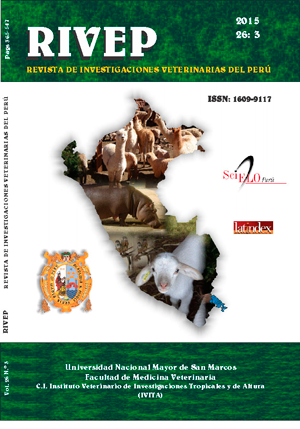Effect of sodium butyrate supplementation on fattening guinea pig (Cavia porcellus) diets on the development of intestinal villi and crypts of Lieberkühn
DOI:
https://doi.org/10.15381/rivep.v26i3.11186Keywords:
guinea pig, sodium butyrate, intestinal development, intestinal morphometryAbstract
The aim of this study was to evaluate the effect of sodium butyrate supplementation on the development of intestinal villi and crypts of Lieberkühn in guinea pigs during the fattening period. A total of 45 male guinea pigs of 14 days of age (weaning age) were distributed in five treatments with nine repetitions per treatment: T1 was the control, T2 received zinc-bacitracin (200 ppm), and T3, T4 and T5 were supplemented with 100, 200 and 300 ppm of sodium butyrate respectively. The length and width of the villi, crypt of Lieberkühn depth and villus length and crypt depth ratio (L/D) in the duodenum, jejunumand ileum were evaluated at 84 days of age. In the length of intestinal villi, the duodenum T5 (0.812 mm) was larger than T1 (0.701 mm), also, T5 and T4 were larger than T3 (p <0.05). The width of ileum villi in T3 (0.114), T4 (0.115) and T5 (0.136 mm) were wider than T1 and T2 (p<0.05). The depth of the intestinal crypt in jejunum and ileum was smaller in T4 and T5 than T1 (p<0.05). The L/D ratio showed that T4 and T5 was higher than T0 in the three intestinal segments (p<0.05). The diet supplemented with sodium butyrate positively affected the intestinal development of guinea pigs during the fattening period as compared to the basal diet.
Downloads
Downloads
Published
Issue
Section
License
Copyright (c) 2015 Diego Vallejos P., Fernando Carcelén C., Ronald Jiménez A., Rosa Perales C., Gilberto Santillán A., Miguel Ara G., William Quevedo, Fernando Carzola

This work is licensed under a Creative Commons Attribution-NonCommercial-ShareAlike 4.0 International License.
AUTHORS RETAIN THEIR RIGHTS:
a. Authors retain their trade mark rights and patent, and also on any process or procedure described in the article.
b. Authors retain their right to share, copy, distribute, perform and publicly communicate their article (eg, to place their article in an institutional repository or publish it in a book), with an acknowledgment of its initial publication in the Revista de Investigaciones Veterinarias del Perú (RIVEP).
c. Authors retain theirs right to make a subsequent publication of their work, to use the article or any part thereof (eg a compilation of his papers, lecture notes, thesis, or a book), always indicating the source of publication (the originator of the work, journal, volume, number and date).



